This is probably the most famous passage in Amazonian anthropology:
I looked up and gasped when I saw a dozen burly, naked, filthy, hideous men staring at us down the shafts of their drawn arrows! Immense wads of green tobacco were stuck between their lower teeth and lips making them look even more hideous, and strands of dark-green slime dripped or hung from their noses.
These naked hideous men were Yanomamö, and, if you ever took an undergaduate anthropology course, you probably read that passage in Napoleon Chagnon’s incredibly popular ethnography, Yanomamo: The Fierce People — the best-selling anthropology text of all time. Chagnon chose the term fierce people for a reason. “The fact that the Yanomamö live in a state of chronic warfare,” he wrote, “is reflected in their mythology, values, settlement pattern, political behavior and marriage practices.” But over the years, Chagnon’s methods, fieldwork, and characterization of the Yanomamö have all been the subject of debate, often acrimonious and sometimes personal.
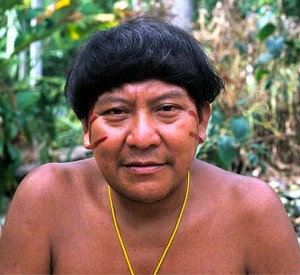 |
| Davi Kopenawa, Yanomamö shaman and activist |
Critics have maintained, among other things, that much of the aggression he observed was instigated, knowingly or not, by Chagnon himself, through his introduction of scarce trade goods, such as machetes and metal pans, into Yanomamö culture. Critics have claimed that his characterization of the Yanomamö as irremediably belligerent has been used to justify incursions and massacres by miners in search of gold in Yanomamö territory, and to justify attempts by Brazilian politicians to split up Yanomamö territory into several small reserves in order to reduce conflict — a plan that would have allowed more gold mining in the region.
And some critics have pointed out that Chagnon has failed to support the Yanomamö in their struggles for autonomy — first, by failing to share with them any of the significant amount of money, allegedly more than a million dollars, that he earned with his popular text; second, by failing to speak out against the misuse of his own work for political purposes; and, third, by publicly criticizing, in a popular Brazilian magazine, Davi Kopenawa, a Yanomamö activist and leader of the indigenous movement that helped to establish the Yanomamö reserve in Brazil.
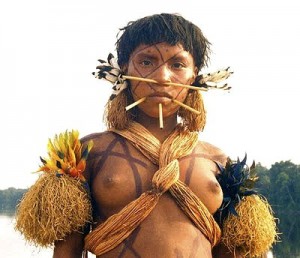 |
| Yanomamö woman with traditional face ornaments |
Kopenawa himself speaks of Chagnon’s work with considerable bitterness. “So this Chagnon,” he says, “he said that the Yanomami are no good, that the Yanomami are ferocious. So this story, he made this story up… To make his book. To make a story about fighting among the Yanomami…. Because in his book he says we are fierce. We are garbage… He thought it would be important for him. He became famous. He is speaking badly about us. He is saying that the Yanomami are fierce, that they fight a lot, that they are no good.”
One of Chagnon’s most controversial claims is that Yanomamö culture exemplifies a key principle of sociobiology — that, among the Yanomamö, the most aggressive and murderous males have the most children. In an article published in 1988 in the prestigious journal Science, he reported that Yanomamö men who had murdered had more than twice as many wives and three times as many children as men who had not. He claimed, in other words, that violence is evolutionary adaptive behavior, and that, as Kim Hill, an expert in human evolutionary ecology, puts it, “the willingness to use violence under some conditions is part of the human male psyche.”
But there are several methodological critiques of Chagnon’s study, of which I will mention just three.
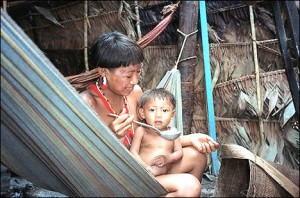 |
| Yanomamö at home |
First, Chagnon used reported body count as an index of aggressiveness. But he had no way to determine with any accuracy the number of people killed by any individual Yanamomö. Chagnon did not himself participate in any raids, witness any killings, or count any bodies. When a Yanomamö man had killed a human, he underwent a relatively rigorous unokaimou purification ceremony, after which he was called an unokai. So Chagnon used participation in the unokaimou as a surrogate for having killed, and he asked raid participants for estimates of the number of their victims.
The problem is that such estimates could be wildly inaccurate, especially because the Yanomamö did not take human body parts as trophies. A raider might shoot several arrows at figures fleeing into the bush at twilight, and claim, rightly or wrongly, to have killed one or more of them. And a man might take part in the unokaimou ceremony when he claimed to have killed by less direct means — by stealing an enemy’s footprint, for example, or by sending a spirit animal to kill him, or by shooting an arrow into his dead body.
Second, for reasons that remain unclear, Chagnon did not count as tokens of reproductive success living children whose fathers were dead or whose fathers lived outside the villages in Chagnon’s study area. Presumably some number of these dead fathers had been killed while they were on raids, and some of those in more distant villages were there in hiding from retaliation for their own violence. Indeed, it was often the war leaders — that is, the most aggressive — who were targeted for death by their enemies, and being killed in one’s prime surely has an impact on one’s long-term reproductive success. If dead or absent unokai and their offspring had been included in the study, the number of offspring of all unokai might well have been lower.
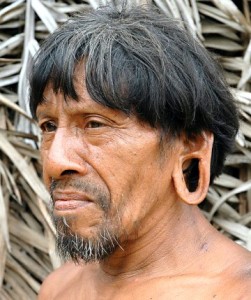 |
| Waorani man with traditional pierced earlobes |
Third, the number of people killed and reproductive success might not be correlated with each other but rather with a third variable — age. The older a man grows, the more raids he will have participated in, and the more children he will have engendered. The study included a large sample of young unmarried males. Since younger unmarried men were unlikely both to have undertaken the unokaimou ceremony and to have fathered numerous children, this cohort skewed the relative reproductive advantages of the unokai, almost all of whom were over thirty. The study did no stratification by age.
And additional hypotheses do not seem to have been considered — for example, that, while members of the raiding party were off on a ten-day raid, their wives were back home being impregnated by the more peaceful males.
Hill, who is a supporter of Chagnon, says that Chagnon’s study is “preliminary and suggestive.” The precise cause of the association between violence and reproductive success, he says, “is not possible to determine from the data presented, and there are many possible interpretations.” An appropriate study would require, among other things. a design “that would eliminate age effects and other possible covariates of both killer status and fitness.”
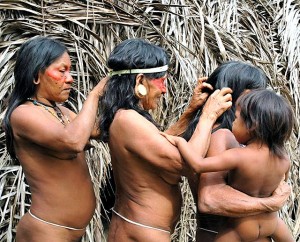 |
| Waorani women |
And just such a study has now been performed by anthropologist Stephen Beckerman of Penn State University and his colleagues, and published in the Proceedings of the National Academy of Sciences. The study was specifically designed to explore Chagnon’s contention that reproductive fitness among men correlates with differences of aggressiveness, and to avoid the three methodological objections to Chagnon’s work that we discussed above. The study concludes that, among another Amazonian people, the Waorani of Ecuador, who at one time had the highest rate of homicide of any society known to anthropology, more aggressive warriors in fact had lower indices of reproductive success than less aggressive males.
As part of the Waorani Life History Project, the authors interviewed 121 Waorani elders of both sexes to obtain genealogical information and recollections of raids in which they and their relatives participated. They also obtained complete raiding histories of 95 warriors, and they analyzed the raiding histories, marital trajectories, and reproductive histories of all these men. “We included in our sample of warriors both living and dead men,” the study states. “We ranked their aggression by the number of raids they participated in and not by a local term of contested meaning with which they are labeled. Our analysis is free of the problem caused by the inherent correlation of the warrior’s age with both participation in raids and reproductive success.”
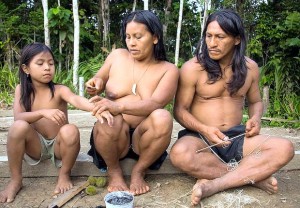 |
| Waorani family |
The result: “Regardless of age category, the more zealous warriors consistently have lower reproductive success.” At each age interval, zealous warriors acquired fewer wives, produced fewer children, and had fewer surviving children.
There are two ways to interpret the reported differences between the Yanomamö and the Waorani. The first is that the disparate outcomes are due to differences in culture. This is the path taken by the authors of the Waorani study. They speculate that Yanomamö warfare cycles had peaceful interludes during which warriors could reap the benefits of their social status and accrue wives and children. The Waorani, on the other hand, did not incorporate peaceful interludes between raids. “We found no tradition of standing down,” the authors state, “even for a short period, after a rough balance of deaths was achieved. Indeed, a balance, although it might occur by chance, was never sought — the goal was to eliminate the other side.”
Another possibility, of course, is that the Yanomamö study was sufficiently affected by the bias introduced by its methodology that its results were incorrect.

- Previous Post: The Gift of Diabetes
- Next Post: A Love Story
- More Articles Related to: Indigenous Culture, Research Studies, The Amazon



Thanks for this info, I hadn’t heard of the recent study. The Yanomamo / Waorani contrast reminds me of the back story to that other evidence of “hard-wired violence”, studies of chimpanzee violence:
“Territorial conflict and closed communities at Gombe and Mahale do not preclude carnivals and open social networks at other sites, and vice versa. We need a better idea of precisely how ecological factors, acting through demographic variables, determine the behavioral options open to chimpanzees at different sites.” (from http://cogprints.org/738/0/Power.html)
The studies in Gombe and Mahale that appeared to show “war” among chimps are disputed; and in any case it’s a particular population. Other populations don’t show the same behaviour.
BTW, nice that you’re a fellow Jodorowsky fan :-)
To gain deep insights into Yanomami life I suggest reading Kenneth Good’s “Into the Heart: One Man’s Pursuit of Love and Knowledge Among the Yanomamia” (1991). NY: Simon and Schuster.
Kenneth Good lived in the forest with the Yanomami for many years and was the first to learn and document their language. Good, who originally went into the forest for his PhD research under Chagnon, realized most of Chagnon’s theories were baseless and erroneous. Instead of ‘fierce people’ he found Yanomami so peaceful and harmonious that he decided to stay and live in the forest, marry into the tribe, and abandon his now meaningless academic thesis. Good’s book is a very personal account of Yanomami life. Highly recommended!
For more info and interesting reviews of “Into The Heart: One Man’s Pursuit of Love and Knowledge Among the Yanomami” see …
http://www.amazon.com/Into-Heart-Pursuit-Knowledge-Yanomami/dp/0673982327
Enjoy!
For more on Kenneth Good and the Yanomamö, take a look at https://singingtotheplants.com/2009/08/love-story/.